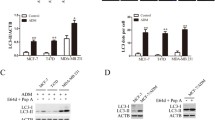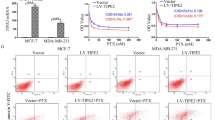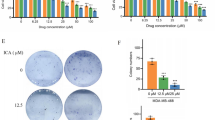Abstract
Since chemotherapy is a main strategy to treat triple-negative breast cancer (TNBC) patients currently, identifying a biomarker to predict chemotherapeutic responses is urgently needed for patients to avoid suffering through unnecessary chemotherapeutic treatments. Here, we found that the endogenous expression of TNFSF13 in a panel of TNBC cell lines highly correlates with paclitaxel (PTX) and doxorubicin IC50 concentrations. Whereas knocking down TNFSF13 enhances PTX effectiveness in PTX-insensitive MDA-MB231 cells, recombinant TNFSF13 (recTNFSF13) desensitizes PTX-sensitive HCC1806 cells to PTX treatment. Moreover, Kaplan-Meier analysis revealed that higher TNFSF13 mRNA expression significantly predicts an increased risk for cancer recurrence in estrogen receptor (ER)-negative breast cancer patients receiving an anthracycline-based treatment. Accordingly, immunohistochemistry experiments indicated that higher levels of TNFSF13 protein are detected in TNBC patients who do not respond to an anthracycline-based treatment. The in silico analysis and Western blotting demonstrated that TNFSF13 expression inversely associates with the activity of the Akt-mTOR pathway, which acts as a negative regulator of autophagy activity. Significantly, the pharmaceutical inhibition of autophagy activity restores the therapeutic effectiveness of PTX in TNFSF13-treated HCC1806 cells. These findings suggest that TNFSF13 can serve as a predictive biomarker for TNBC patients, who can use it to decide whether to receive chemotherapy.
Key messages
-
TNFSF13 upregulation correlates with a poor response to chemotherapy in TNBCs.
-
TNFSF13 promotes autophagy initiation in chemotherapeutic resistant TNBCs.
-
Therapeutic targeting of autophagy initiation overcomes the TNFSF13-related chemoresistance.
-
TNFSF13 could be a predictive biomarker for TNBC patients receiving chemotherapy.






Similar content being viewed by others
References
Siegel L, Miller KD, Jemal A (2019) Cancer statistics 2019. CA Cancer J Clin 69(1):7–34
Desmedt C, Haibe-Kains B, Wirapati P, Buyse M, Larsimont D, Bontempi G, Delorenzi M, Piccart M, Sotiriou C (2008) Biological processes associated with breast cancer clinical outcome depend on the molecular subtypes. Clin Cancer Res 14(16):5158–5165
Brouckaert O, Wildiers H, Floris G, Neven P (2012) Update on triple-negative breast cancer: prognosis and management strategies. Int J Women's Health 4:511–520
Goldhirsch A (2013) Personalized adjuvant therapies: lessons from the past: the opening address by the St. Gallen 2013 award recipient. Breast 22(Suppl 2):S3–S7
Yersal O, Barutca S (2014) Biological subtypes of breast cancer: prognostic and therapeutic implications. World J Clin Oncol 5(3):412–424
Wein L, Loi S (2017) Mechanisms of resistance of chemotherapy in early-stage triple negative breast cancer (TNBC). Breast 34(Suppl 1):S27–S30
Gnant M, Harbeck N, Thomssen C (2017) St. Gallen/Vienna 2017: A brief summary of the consensus discussion about escalation and de-escalation of primary breast cancer treatment. Breast Care (Basel) 12(2):102–107
Ishigami E, Sakakibara M, Sakakibara J, Masuda T, Fujimoto H, Hayama S, Nagashima T, Sangai T, Nakagawa A, Nakatani Y, Otsuka M (2019) Coexistence of regulatory B cells and regulatory T cells in tumor-infiltrating lymphocyte aggregates is a prognostic factor in patients with breast cancer. Breast Cancer 26(2):180–189
Chen YZ, Kim Y, Soliman HH, Ying G, Lee JK (2018) Single drug biomarker prediction for ER- breast cancer outcome from chemotherapy. Endocr Relat Cancer 25(6):595–605
Stein JV, Lopez-Fraga M, Elustondo FA, Carvalho-Pinto CE, Rodriguez D, Gomez-Caro R, De Jong J, Martinez AC, Medema JP, Hahne M (2002) APRIL modulates B and T cell immunity. J Clin Invest 109(12):1587–1598
Dillon SR, Gross JA, Ansell SM, Novak AJ (2006) An APRIL to remember: novel TNF ligands as therapeutic targets. Nat Rev Drug Discov 5(3):235–246
Xu S, Lam KP (2001) B-cell maturation protein, which binds the tumor necrosis factor family members BAFF and APRIL, is dispensable for humoral immune responses. Mol Cell Biol 21(12):4067–4074
Hahne M, Kataoka T, Schroter M, Hofmann K, Irmler M, Bodmer JL, Schneider P, Bornand T, Holler N, French LE et al (1998) APRIL, a new ligand of the tumor necrosis factor family, stimulates tumor cell growth. J Exp Med 188(6):1185–1190
Tai YT, Acharya C, An G, Moschetta M, Zhong MY, Feng X, Cea M, Cagnetta A, Wen K, van Eenennaam H, van Elsas A, Qiu L, Richardson P, Munshi N, Anderson KC (2016) APRIL and BCMA promote human multiple myeloma growth and immunosuppression in the bone marrow microenvironment. Blood 127(25):3225–3236
Tai YT, Lin L, Xing L, Cho SF, Yu T, Acharya C, Wen K, Hsieh PA, Dulos J, van Elsas A, Munshi N, Richardson P, Anderson KC (2019) APRIL signaling via TACI mediates immunosuppression by T regulatory cells in multiple myeloma: therapeutic implications. Leukemia 33(2):426–438
Liu X, Ji XM, Du XN, Zong XC, Liang DF, Ma L, Wu HT, Zhang SQ (2013) Molecular cloning, expression, bioinformatics analysis, and bioactivity of TNFSF13 (APRIL) in the South African clawed frog (Xenopus laevi): a new model to study immunological diseases. OMICS 17(7):384–392
Sandberg WJ, Otterdal K, Gullestad L, Halvorsen B, Ragnarsson A, Froland SS, Damas JK, Oie E, Aukrust P, Hansson GK et al (2009) The tumour necrosis factor superfamily ligand APRIL (TNFSF13) is released upon platelet activation and expressed in atherosclerosis. Thromb Haemost 102(4):704–710
Xiao Y, Motomura S, Podack ER (2008) APRIL (TNFSF13) regulates collagen-induced arthritis, IL-17 production and Th2 response. Eur J Immunol 38(12):3450–3458
Pelekanou V, Notas G, Theodoropoulou K, Kampa M, Takos D, Alexaki VI, Radojicic J, Sofras F, Tsapis A, Stathopoulos EN, Castanas E (2011) Detection of the TNFSF members BAFF, APRIL, TWEAK and their receptors in normal kidney and renal cell carcinomas. Anal Cell Pathol (Amst) 34(1–2):49–60
Alexaki VI, Pelekanou V, Notas G, Venihaki M, Kampa M, Dessirier V, Sabour-Alaoui S, Stathopoulos EN, Tsapis A, Castanas E (2012) B-cell maturation antigen (BCMA) activation exerts specific proinflammatory effects in normal human keratinocytes and is preferentially expressed in inflammatory skin pathologies. Endocrinology 153(2):739–749
Notas G, Alexaki VI, Kampa M, Pelekanou V, Charalampopoulos I, Sabour-Alaoui S, Pediaditakis I, Dessirier V, Gravanis A, Stathopoulos EN, Tsapis A, Castanas E (2012) APRIL binding to BCMA activates a JNK2-FOXO3-GADD45 pathway and induces a G2/M cell growth arrest in liver cells. J Immunol 189(10):4748–4758
Liu Z, Liao L, Cao Z, Chen X, Du J (2017) Synergisic effect of APRIL knockdown and Jiedu Xiaozheng Yin, a Chinese medicinal recipe, on the inhibition of hepatocellular carcinoma cell proliferation. Oncol Rep 37(2):754–760
Pelekanou V, Notas G, Kampa M, Tsentelierou E, Stathopoulos EN, Tsapis A, Castanas E (2013) BAFF, APRIL, TWEAK, BCMA, TACI and Fn14 proteins are related to human glioma tumor grade: immunohistochemistry and public microarray data meta-analysis. PLoS One 8(12):e83250
Deshayes F, Lapree G, Portier A, Richard Y, Pencalet P, Mahieu-Caputo D, Horellou P, Tsapis A (2004) Abnormal production of the TNF-homologue APRIL increases the proliferation of human malignant glioblastoma cell lines via a specific receptor. Oncogene 23(17):3005–3012
García-Castro A, Zonca M, Florindo-Pinheiro D, Carvalho-Pinto CE, Cordero A, Gutiérrez del Burgo B, García-Grande A, Mañes S, Hahne M, González-Suárez E, Planelles L (2015) APRIL promotes breast tumor growth and metastasis and is associated with aggressive basal breast cancer. Carcinogenesis 36(5):574–584
Zhi X, Tao J, Xiang G, Cao H, Liu Z, Yang K, Lv C, Ni S (2015) APRIL induces cisplatin resistance in gastric cancer cells via activation of the NF-kappaB pathway. Cell Physiol Biochem 35(2):571–585
Dezso Z, Oestreicher J, Weaver A, Santiago S, Agoulnik S, Chow J, Oda Y, Funahashi Y (2014) Gene expression profiling reveals epithelial mesenchymal transition (EMT) genes can selectively differentiate eribulin sensitive breast cancer cells. PLoS One 9(8):e106131
Li Y, Zou L, Li Q, Haibe-Kains B, Tian R, Li Y, Desmedt C, Sotiriou C, Szallasi Z, Iglehart JD, Richardson AL, Wang ZC (2010) Amplification of LAPTM4B and YWHAZ contributes to chemotherapy resistance and recurrence of breast cancer. Nat Med 16(2):214–218
Aguirre-Gamboa R, Gomez-Rueda H, Martinez-Ledesma E, Martinez-Torteya A, Chacolla-Huaringa R, Rodriguez-Barrientos A, Tamez-Pena JG, Trevino V (2013) SurvExpress: an online biomarker validation tool and database for cancer gene expression data using survival analysis. PLoS One 8(9):e74250
Dibble CC, Cantley LC (2015) Regulation of mTORC1 by PI3K signaling. Trends Cell Biol 25(9):545–555
Jung CH, Ro SH, Cao J, Otto NM, Kim DH (2010) mTOR regulation of autophagy. FEBS Lett 584(7):1287–1295
Kang R, Zeh HJ, Lotze MT, Tang D (2011) The Beclin 1 network regulates autophagy and apoptosis. Cell Death Differ 18(4):571–580
Girardi JP, Pereira L, Bakovic M (2011) De novo synthesis of phospholipids is coupled with autophagosome formation. Med Hypotheses 77(6):1083–1087
Dent R, Trudeau M, Pritchard KI, Hanna WM, Kahn HK, Sawka CA, Lickley LA, Rawlinson E, Sun P, Narod SA (2007) Triple-negative breast cancer: clinical features and patterns of recurrence. Clin Cancer Res 13(15 Pt 1):4429–4434
Foulkes WD, Smith IE, Reis-Filho JS (2010) Triple-negative breast cancer. N Engl J Med 363(20):1938–1948
Ross JS, Hatzis C, Symmans WF, Pusztai L, Hortobagyi GN (2008) Commercialized multigene predictors of clinical outcome for breast cancer. Oncologist 13(5):477–493
Ryan MC, Grewal IS (2009) Targeting of BAFF and APRIL for autoimmunity and oncology. Adv Exp Med Biol 647:52–63
Qian Z, Qingshan C, Chun J, Huijun Z, Feng L, Qiang W, Qiang X, Min Z (2014) High expression of TNFSF13 in tumor cells and fibroblasts is associated with poor prognosis in non-small cell lung cancer. Am J Clin Pathol 141(2):226–233
Pelekanou V, Notas G, Athanasouli P, Alexakis K, Kiagiadaki F, Peroulis N, Kalyvianaki K, Kampouri E, Polioudaki H, Theodoropoulos P, Tsapis A, Castanas E, Kampa M (2018) BCMA (TNFRSF17) induces APRIL and BAFF mediated breast cancer cell stemness. Front Oncol 8:301
Pan X, Chen Y, Shen Y, Tantai J (2019) Knockdown of TRIM65 inhibits autophagy and cisplatin resistance in A549/DDP cells by regulating miR-138-5p/ATG7. Cell Death Dis 10(6):429
Ma H, Li Y, Wang X, Wu H, Qi G, Li R, Yang N, Gao M, Yan S, Yuan C, Kong B (2019) PBK, targeted by EVI1, promotes metastasis and confers cisplatin resistance through inducing autophagy in high-grade serous ovarian carcinoma. Cell Death Dis 10(3):166
Chen Z, Jiang Q, Zhu P, Chen Y, Xie X, Du Z, Jiang L, Tang W (2019) NPRL2 enhances autophagy and the resistance to Everolimus in castration-resistant prostate cancer. Prostate 79(1):44–53
Wang M, Han D, Yuan Z, Hu H, Zhao Z, Yang R, Jin Y, Zou C, Chen Y, Wang G, Gao X, Wang X (2018) Long non-coding RNA H19 confers 5-Fu resistance in colorectal cancer by promoting SIRT1-mediated autophagy. Cell Death Dis 9(12):1149
Xiao X, Wang W, Li Y, Yang D, Li X, Shen C, Liu Y, Ke X, Guo S, Guo Z (2018) HSP90AA1-mediated autophagy promotes drug resistance in osteosarcoma. J Exp Clin Cancer Res 37(1):201
Das CK, Parekh A, Parida PK, Bhutia SK, Mandal M (2019) Lactate dehydrogenase A regulates autophagy and tamoxifen resistance in breast cancer. Biochim Biophys Acta Mol Cell Res 1866(6):1004–1018
Lee MH, Koh D, Na H, Ka NL, Kim S, Kim HJ, Hong S, Shin YK, Seong JK, Lee MO (2018) MTA1 is a novel regulator of autophagy that induces tamoxifen resistance in breast cancer cells. Autophagy 14(5):812–824
Nagelkerke A, Sieuwerts AM, Bussink J, Sweep FC, Look MP, Foekens JA, Martens JW, Span PN (2014) LAMP3 is involved in tamoxifen resistance in breast cancer cells through the modulation of autophagy. Endocr Relat Cancer 21(1):101–112
Zhang P, Liu X, Li H, Chen Z, Yao X, Jin J, Ma X (2017) TRPC5-induced autophagy promotes drug resistance in breast carcinoma via CaMKKbeta/AMPKalpha/mTOR pathway. Sci Rep 7(1):3158
Chen S, Zhu X, Qiao H, Ye M, Lai X, Yu S, Ding L, Wen A, Zhang J (2016) Protective autophagy promotes the resistance of HER2-positive breast cancer cells to lapatinib. Tumour Biol 37(2):2321–2331
Vazquez-Martin A, Oliveras-Ferraros C, Menendez JA (2009) Autophagy facilitates the development of breast cancer resistance to the anti-HER2 monoclonal antibody trastuzumab. PLoS One 4(7):e6251
Das CK, Linder B, Bonn F, Rothweiler F, Dikic I, Michaelis M, Cinatl J, Mandal M, Kogel D (2018) BAG3 overexpression and cytoprotective autophagy mediate apoptosis resistance in chemoresistant breast cancer cells. Neoplasia 20(3):263–279
Zhang LH, Yang AJ, Wang M, Liu W, Wang CY, Xie XF, Chen X, Dong JF, Li M (2016) Enhanced autophagy reveals vulnerability of P-gp mediated epirubicin resistance in triple negative breast cancer cells. Apoptosis 21(4):473–488
Jiang GM, Tan Y, Wang H, Peng L, Chen HT, Meng XJ, Li LL, Liu Y, Li WF, Shan H (2019) The relationship between autophagy and the immune system and its applications for tumor immunotherapy. Mol Cancer 18(1):17–38
Acknowledgment
The authors would like to thank Dr. Michael Hsiao from Academia Sinica in Taiwan for kindly providing TNBC cell lines.
Funding
This study was supported by the Ministry of Science and Technology, Taiwan to Yuan-Feng Lin (MOST 108-2320-B-038-017-MY3) and Hui-Yu Lin (MOST 108-2314-B-567-002), and Cardinal Tien Hospital, Xindian District, New Taipei City, Taiwan (CTH108A-2A02) to Hui-Yu Lin.
Author information
Authors and Affiliations
Contributions
HYL, HHL, CHK, CHL, CLC, and YFL participated in data collection and analysis. HYL, YLC, CLC, and YFL participated in the design of the study. HYL, CLC, and YFL participated in the writing the manuscript and the data interpretation. All authors read and approved the final manuscript.
Corresponding author
Ethics declarations
Conflict of interest
The authors declare that they have no conflict of interest.
Ethical approval
This study was conducted with the approval of the local ethics committee (Cardinal Tien Hospital, New Taipei City, Taiwan, CTH-101-3-5-054).
Additional information
Publisher’s note
Springer Nature remains neutral with regard to jurisdictional claims in published maps and institutional affiliations.
Electronic supplementary material
ESM 1
(PDF 1408 kb)
Rights and permissions
About this article
Cite this article
Lin, HY., Kuei, CH., Lee, HH. et al. TNFSF13 upregulation confers chemotherapeutic resistance via triggering autophagy initiation in triple-negative breast cancer. J Mol Med 98, 1255–1267 (2020). https://doi.org/10.1007/s00109-020-01952-5
Received:
Revised:
Accepted:
Published:
Issue Date:
DOI: https://doi.org/10.1007/s00109-020-01952-5




